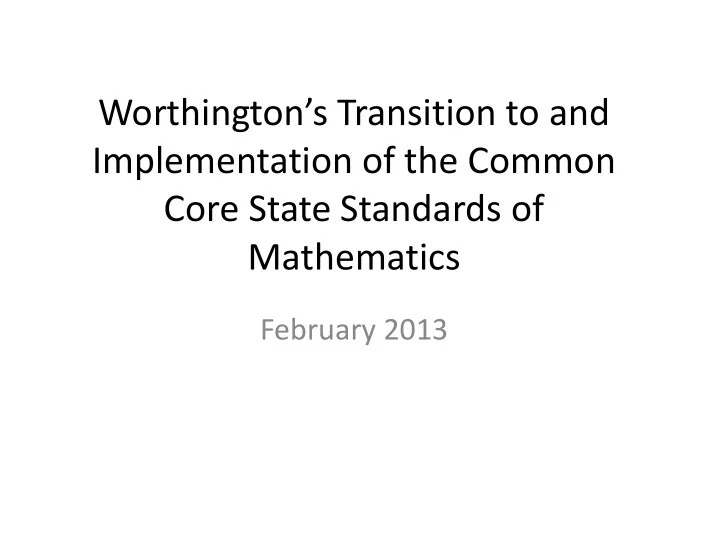

Worthington’s Transition to and Implementation of the Common Core State Standards of Mathematics February 2013
Common Core Standards provide a consistent, clear understanding of what students are expected to learn, so teachers and parents know what they need to do to help them……robust and relevant to real world….. need for success in college and careers …. able to compete successfully in the global economy. www.corestandards.org
Major Themes • All students means ALL students • The work is about improving instruction, which requires that teachers collaborate to reach more students more of the time
Standards for Mathematical Practice Mathematical ‘Habits of Mind’
CCSS PRINCIPLES • Focus • Identifies key ideas, understandings and skills for each grade or course • Stresses deep learning, which means applying concepts and skills within the same grade or course • Coherence • Articulates a progression of topics across grades and connects to other topics • Vertical growth that reflects the nature of the discipline • Rigor • Pursuit of conceptual understanding, procedural skill and application
Standards Progressions
CCSS DOMAIN PROGRESSION K 1 2 3 4 5 6 7 8 HS Counting & Cardinality Ratios and Proportional Number and Operations in Base Ten Relationships Number & Quantity Number and Operations – The Number System Fractions Expressions and Equations Algebra Operations and Algebraic Thinking Functions Functions Geometry Geometry Statistics & Measurement and Data Statistics and Probability Probability
HIGH SCHOOL MATHEMATICS PATHWAYS • CCSS Appendix A, developed by Achieve Typical • Two main pathways: in U.S. • Traditional: Two algebra courses and a geometry course, with statistics and probability in each • Integrated: Three courses, each of which includes algebra, geometry, statistics, and probability • Both pathways: Typical outside U.S. • Complete the Core in the third year • Include the same “critical areas” • Require rethinking high school mathematics • Prepare students for a menu of fourth-year courses
Worthington Implementation • K-2 are implementing this school year using a Common Core program Stepping Stones • Grades 3-5 will use Stepping Stones 2013-14 • Courses in grades 6-12 are being developed for implementation in Fall 2013 Scope and sequences are guiding how current resources and other options will be used in development of the courses.
Example Scope and Sequence Algebra, Geometry and Statistics and Probability topics are integrated in each of the high school courses, Math 1, Math 2 and Math 3
Excerpt from Course Progression Chart
Assessment Design English Language Arts/Literacy and Mathematics, Grades 3-11 2 Optional Assessments/Flexible Administration Mid-Year Assessment Performance-Based Diagnostic Assessment End-of-Year • Performance-based • Early indicator of Assessment (PBA) Assessment • Emphasis on hard- • Extended tasks student knowledge • Innovative, • Applications of to-measure and skills to inform computer-based standards concepts and skills instruction, supports, items • Potentially • Required and PD • Required • Non-summative summative Required Speaking And Listening Assessment • Locally scored • Non-summative, required 12
Goal #1: Create High Quality Assessments • To address the priority purposes, PARCC will develop an assessment system comprised of four components . Each component will be computer-delivered and will leverage technology to incorporate innovations. – Two summative, required assessment components designed to o Make “college - and career- readiness” and “on - track” determinations o Measure the full range of standards and full performance continuum o Provide data for accountability uses, including measures of growth – Two non-summative, optional assessment components designed to o Generate timely information for informing instruction, interventions, and professional development during the school year o An additional third non- summative component will assess students’ speaking and listening skills 13
Overview of Mathematics Task Types PARCC mathematics assessments will include three types of tasks. Task Type Description of Task Type • I. Tasks assessing Balance of conceptual understanding, fluency, and application • concepts, skills and Can involve any or all mathematical practice standards • procedures Machine scorable including innovative, computer-based formats • Will appear on the End of Year and Performance Based Assessment components • II. Tasks assessing Each task calls for written arguments / justifications, critique of expressing reasoning, or precision in mathematical statements (MP.3, 6). • mathematical Can involve other mathematical practice standards • reasoning May include a mix of machine scored and hand scored responses • Included on the Performance Based Assessment component • III. Tasks assessing Each task calls for modeling/application in a real-world context or modeling / scenario (MP.4) • applications Can involve other mathematical practice standards. • May include a mix of machine scored and hand scored responses • Included on the Performance Based Assessment component 14 For more information see PARCC Item Development ITN Appendix D.
What is NOT covered in the CCSM? • How teachers should teach • All that should be taught • Reflection of variety of abilities, needs, learning rates, achievement levels • The “whole” of readiness – social, emotional, physical development
Responses to the challenges of implementation Units for CCSSM are being created from current textbooks both hardcopy and online Leverage resources with limited financial support Making an effort to focus instruction which reduces repetition in content Develop formative assessments which provides insight into student thinking Have intervention options for students who have weaknesses Communication plan of new course progression to students and parents Develop strategies for content-based professional learning in collaboration with other teachers to maximize the instructional opportunities for the students
Closing Thought • “These Standards are not intended to be new names for old ways of doing business. They are a call to take the next step. It is time for states to work together to build on lessons learned from two decades of standards based reforms. It is time to recognize that standards are not just promises to our children, but promises we intend to keep.” (CCSS, 2010, p. 5)
Recommend
More recommend